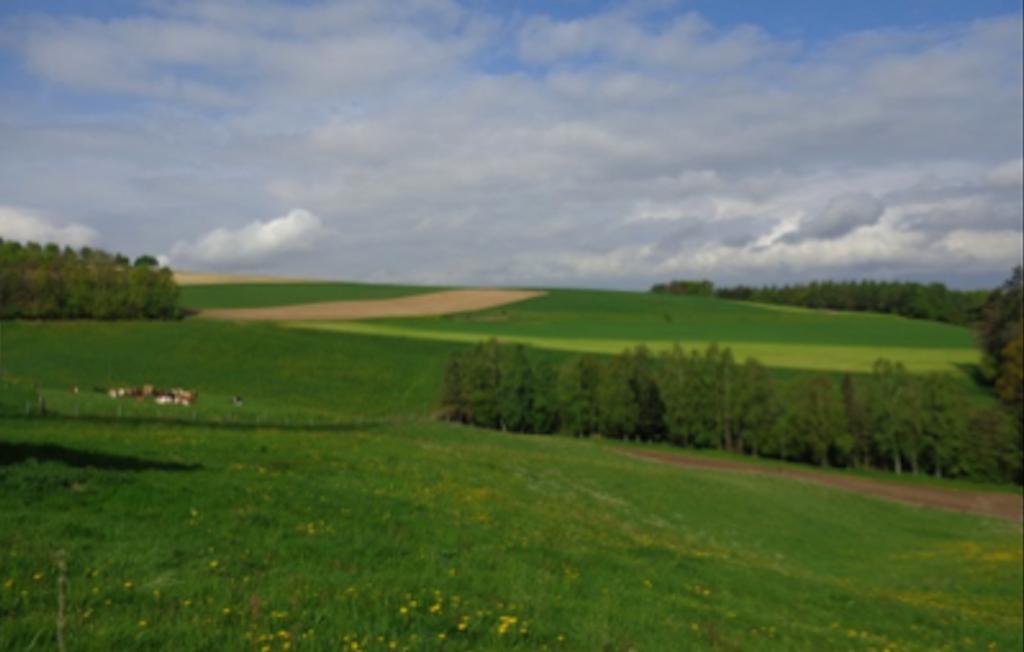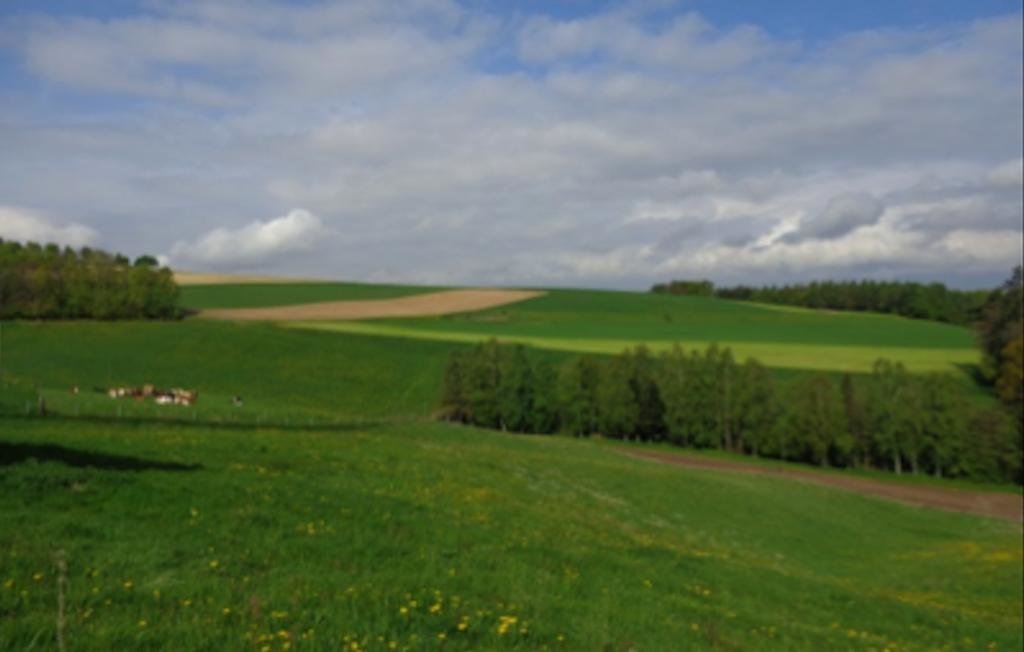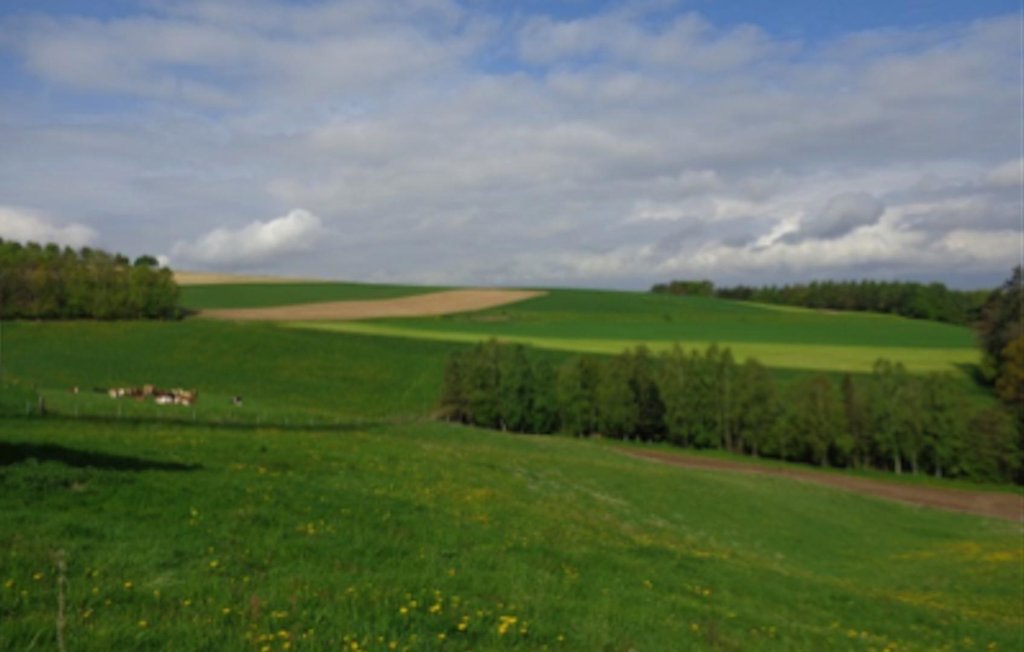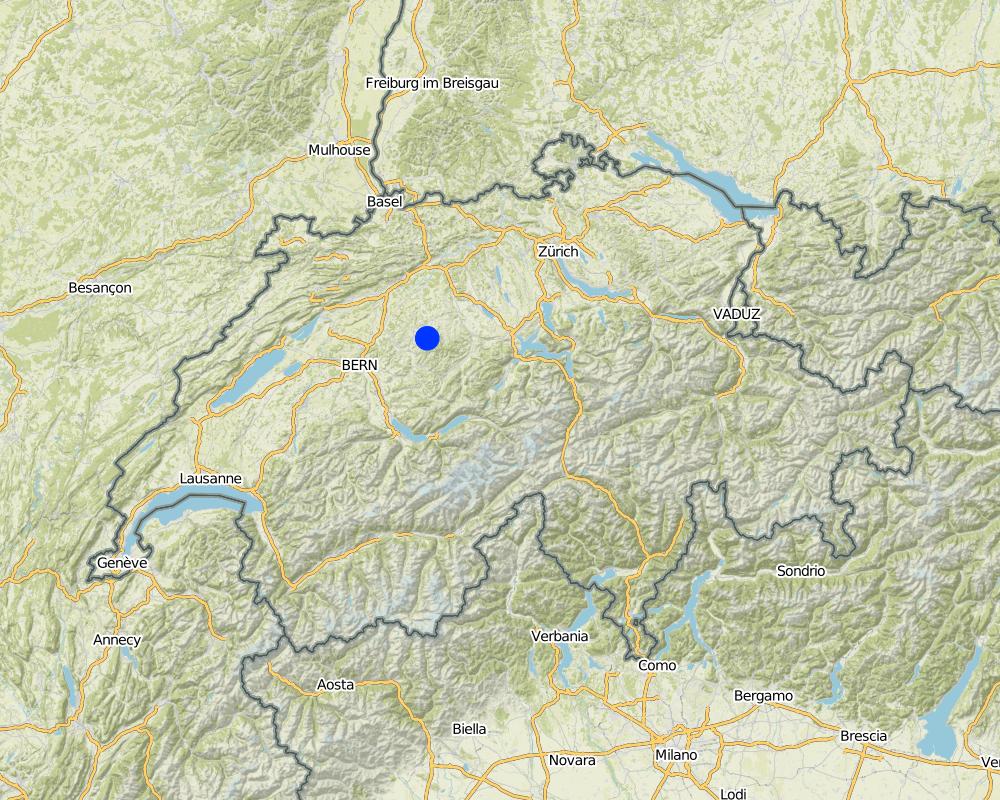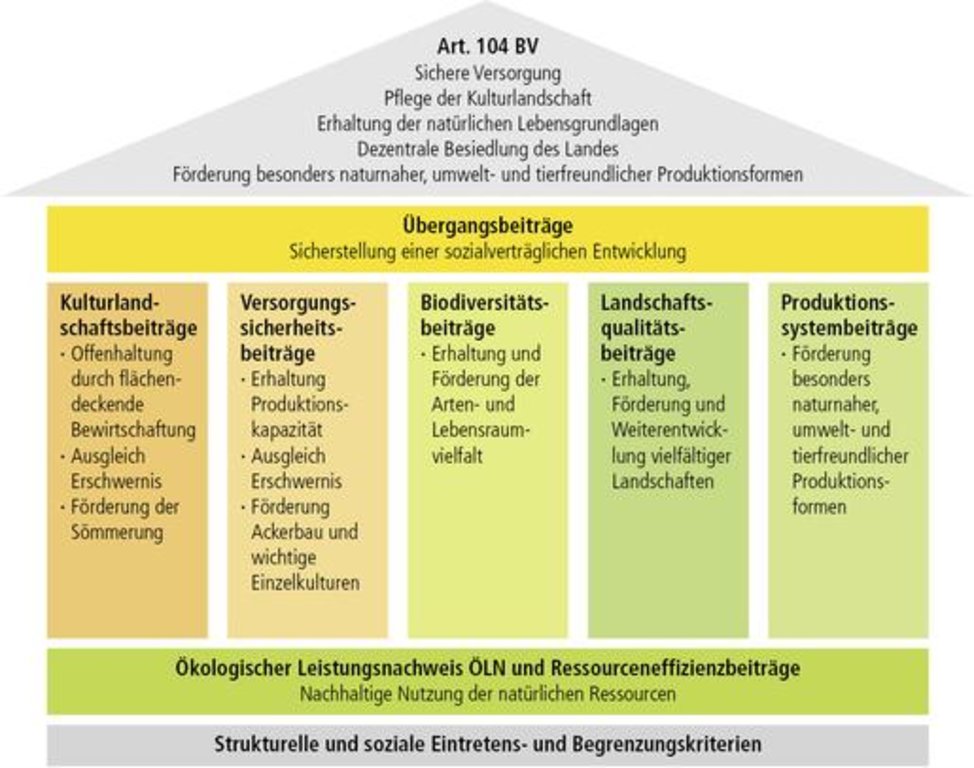Direct Payment System [Suisse]
- Création :
- Mise à jour :
- Compilateur : Deborah Niggli
- Rédacteur : –
- Examinateur : David Streiff
Direktzahlungssystem
approaches_2602 - Suisse
Voir les sections
Développer tout Réduire tout1. Informations générales
1.2 Coordonnées des personnes-ressources et des institutions impliquées dans l'évaluation et la documentation de l'Approche
Nom du projet qui a facilité la documentation/ l'évaluation de l'Approche (si pertinent)
Preventing and Remediating degradation of soils in Europe through Land Care (EU-RECARE )Nom du ou des institutions qui ont facilité la documentation/ l'évaluation de l'Approche (si pertinent)
University of Bern, Institute of Geography (GIUB) - Suisse1.3 Conditions relatives à l'utilisation par WOCAT des données documentées
Quand les données ont-elles été compilées (sur le terrain)?
23/06/2015
Le compilateur et la(les) personne(s) ressource(s) acceptent les conditions relatives à l'utilisation par WOCAT des données documentées:
Oui
2. Description de l'Approche de GDT
2.1 Courte description de l'Approche
Financial aid of the government to land users to compensate for loss of financial output of crops.
2.2 Description détaillée de l'Approche
Description détaillée de l'Approche:
Aims / objectives: The main aim is to maintain agriculture and its production of goods. Because of the small amount of financial output for a land user and its products in Switzerland, there are direct payments to the land user paid per area size. These payments are substantial for every land user but especially in mountain regions of Switzerland to compensate land users for their work for nature and environment. Another goal is to keep the nutrient security of Switzerland alive. This goal can only be reached by supplementary payments in order to produce agricultural goods competitively.
Methods: Direct payments mean financial sums paid to a land user per area size. They differ from position of the field. A land user must apply for the direct payments in autumn. During winter the land user must mark his fields and their use online. Payments are reached three times during the following year: in June, autumn and winter.
Stages of implementation: The beginning of direct payments is in the 1980s when there were payments for livestock owners. Before there were never direct financial payments to land users but the agricultural products were financed by the government itself and land users got a fixed price for their products. 1989 land users got direct payments for the first time under the programs IP Suisse and ÖLN. Today payments are calculated by area size.
Role of stakeholders: The direct payment system is mainly a political issue. Politicians make budgets for the total amount of direct payments each year. Moreover, they can make new rules and obligations for land users. The land user must always adopt himself and his technology and crop rotation to these changes. This can be very difficult. Land users are represented by their unions but there is no space for individual opinions or direct participation in the system.
2.3 Photos de l'approche
2.5 Pays/ région/ lieux où l'Approche a été appliquée
Pays:
Suisse
Région/ Etat/ Province:
Bern
Autres spécifications du lieu :
Frienisberg
Commentaires:
Total Switzerland
Map
×2.6 Dates de début et de fin de l'Approche
Indiquez l'année de démarrage:
1989
2.7 Type d'Approche
- fondé sur un projet/ programme
2.8 Principaux objectifs de l'Approche
The Approach focused mainly on SLM with other activities (Maintenance of a good financial situation for Swiss land users)
The system wants to support Swiss Agriculture on a financial basis. Because agricultural products are produced under swiss conditions regarding wages, soil prices etc. the products can not compete against other products from abroad. The direct payments close the gap between the theoretical value of a product and its end price in stores.
The SLM Approach addressed the following problems: The system of direct payments gives wrong appeals to the land users. Because payments are made by area size land users want to expand their farm size even more. But there is also more work to do if a farm is bigger. The system also provokes cultivation of fields that are at risk for erosion or other consequences because it does not differ from fields that are at risk and fields that are not. It is only the size that matters.
2.9 Conditions favorisant ou entravant la mise en œuvre de la(des) Technologie(s) appliquée(s) sous l'Approche
disponibilité/ accès aux ressources et services financiers
- entrave
Rentability of conservational agriculture and its technologies were often discussed because there may be losses at the beginning.
Treatment through the SLM Approach: Because of financial payments losses of financial capital can be compensated.
3. Participation et rôles des parties prenantes impliquées dans l'Approche
3.1 Parties prenantes impliquées dans l'Approche et rôles
- exploitants locaux des terres / communautés locales
- ONG
- gouvernement local
- gouvernement national (planificateurs, décideurs)
Si plusieurs parties prenantes sont impliquées, indiquez l'organisme chef de file ou l'institution responsable:
government
3.2 Participation des exploitants locaux des terres/ communautés locales aux différentes phases de l'Approche
| Participation des exploitants locaux des terres/ communautés locales | Spécifiez qui était impliqué et décrivez les activités | |
|---|---|---|
| initiation/ motivation | passive | |
| planification | passive | |
| mise en œuvre | soutien extérieur | |
| suivi/ évaluation | interactive | |
| Research | aucun |
3.3 Diagramme/ organigramme (si disponible)
3.4 Prises de décision pour la sélection de la Technologie/ des Technologies
Indiquez qui a décidé de la sélection de la Technologie/ des Technologies à mettre en œuvre:
- principalement les exploitants des terres soutenus par des spécialistes de la GDT
Expliquez:
Decisions on the method of implementing the SLM Technology were made by mainly by land users supported by SLM specialists
4. Soutien technique, renforcement des capacités et gestion des connaissances
4.1 Renforcement des capacités/ formation
Une formation a-t-elle été dispensée aux exploitants des terres/ autres parties prenantes?
Oui
Spécifiez qui a été formé:
- exploitants des terres
Formats de la formation:
- sur le tas
- zones de démonstration
Thèmes abordés:
There was also an overthinking on the side of land users. Some of them did not change environmentally good technologies after there were less payments for this technology because they saw the advantages of their technology. However, without a financial support at the beginning they would not have implemented new technologies.
4.2 Service de conseils
Les exploitants des terres ont-ils accès à un service de conseils?
Oui
Spécifiez si le service de conseils est fourni:
- dans les champs des exploitants?
- dans des centres permanents
Décrivez/ commentez:
Advisory service is very adequate to ensure the continuation of land conservation activities
4.3 Renforcement des institutions (développement organisationnel)
Des institutions ont elles été mises en place ou renforcées par le biais de l'Approche?
- non
4.4 Suivi et évaluation
Le suivi et l'évaluation font ils partie de l'Approche? :
Oui
Commentaires:
bio-physical aspects were ad hoc monitored by government through observations; indicators: None
socio-cultural aspects were ad hoc monitored by government through observations; indicators: None
economic / production aspects were ad hoc monitored by government through observations; indicators: None
area treated aspects were ad hoc monitored by government through observations; indicators: None
no. of land users involved aspects were ad hoc monitored by government through measurements; indicators: None
management of Approach aspects were ad hoc monitored by None through observations; indicators: None
There were few changes in the Approach as a result of monitoring and evaluation: None
There were few changes in the Technology as a result of monitoring and evaluation: None
4.5 Recherche
La recherche a-t-elle fait partie intégrante de l’Approche?
Oui
Spécifiez les thèmes:
- économie/ marketing
Donnez plus de détails et indiquez qui a mené ces recherches:
Research was carried out on station
5. Financement et soutien matériel externe
5.1 Budget annuel de la composante GDT de l'Approche
Si le budget annuel précis n'est pas connu, indiquez une fourchette:
- > 1 000 000
Commentez (par ex. principales sources de financement/ principaux bailleurs de fonds):
Approach costs were met by the following donors: government (projects): 50.0%; national non-government (soil support program): 10.0%; local government (district, county, municipality, village etc): 40.0%
5.2 Soutiens financiers/ matériels fournis aux exploitants des terres
Les exploitants des terres ont-ils reçu un soutien financier/ matériel pour la mise en œuvre de la Technologie/ des Technologies?
Oui
5.3 Subventions pour des intrants spécifiques (incluant la main d'œuvre)
- intrants agricoles
| Spécifiez les intrants subventionnés | Dans quelle mesure | Spécifiez les subventions |
|---|---|---|
| semences | entièrement financé | |
- autre
| Autre (spécifiez) | Dans quelle mesure | Spécifiez les subventions |
|---|---|---|
| area size | entièrement financé | cultivation per ha |
5.4 Crédits
Des crédits ont-ils été alloués à travers l'Approche pour les activités de GDT?
Non
6. Analyses d'impact et conclusions
6.1 Impacts de l'Approche
Est-ce que l'Approche a aidé les exploitants des terres à mettre en œuvre et entretenir les Technologies de GDT?
- Non
- Oui, un peu
- Oui, modérément
- Oui, beaucoup
There are payments for conservational agriculture and technologies. Therefore, SLM is applied there. However, there are also payments for conventional agriculture and technologies and the attractiveness to change a cultivation system is not very high.
Did other land users / projects adopt the Approach?
- Non
- Oui, un peu
- Oui, modérément
- Oui, beaucoup
about 97%
Did the Approach lead to improved livelihoods / human well-being?
- Non
- Oui, un peu
- Oui, modérément
- Oui, beaucoup
6.2 Principale motivation des exploitants des terres pour mettre en œuvre la GDT
- augmenter la production
- augmenter la rentabilité/ bénéfice, rapport coûts-bénéfices
- réduire la charge de travail
- paiements/ subventions
- conscience environnementale
6.3 Durabilité des activités de l'Approche
Les exploitants des terres peuvent-ils poursuivre ce qui a été mis en œuvre par le biais de l'Approche (sans soutien extérieur)?
- non
Si non ou incertain, spécifiez et commentez:
The current agricultural system in Switzerland can not run without direct payments and financial support of the land users.
6.4 Points forts/ avantages de l'Approche
| Points forts/ avantages/ possibilités du point de vue de l'exploitant des terres |
|---|
| The payments are a security of income for the land users. Therefore he continues his production of agricultural products. (How to sustain/ enhance this strength: The payment must be enough high so that it is accurate for the labour and work of a land user on the fields. This must also be a point regarding future payments.) |
| Points forts/ avantages/ possibilités du point de vue du compilateur ou d'une autre personne ressource clé |
|---|
| It is a fair system: a land user only gets paid for his work on a field. (How to sustain/ enhance this strength: A good life for a land user and his family is possible through the financial aid of the direct payment system. This must be maintained.) |
6.5 Faiblesses/ inconvénients de l'Approche et moyens de les surmonter
| Faiblesses/ inconvénients/ risques du point de vue de l’exploitant des terres | Comment peuvent-ils être surmontés? |
|---|---|
| A fixed product price would be the solution to higher payments. The situation from the beginning of the system was much better. | Product prices must be on a similar level. However, this is not possible. |
| Faiblesses/ inconvénients/ risques du point de vue du compilateur ou d'une autre personne ressource clé | Comment peuvent-ils être surmontés? |
|---|---|
| The system provides some dependence for the land user. He can not produce competitively without supplementary payments. | Fair product prices and competitiveness would be the solution, but this is impossible to reach. |
| There are many differences during short time regarding the sum and conditions of direct payments. A land user has thereby no chance of adopting himself to the new conditions. | Payments must be stable during a longer time. Only then a land user is able to change his cultivation system. |
| The system leads to wrong cultivation of fields because a land user wants as much area size as possible. This endangers soil and can lead to erosion. | The system should be reduced to only not-endangered fields and provide payments for the non-cultivation of endangered fields. |
7. Références et liens
7.1 Méthodes/ sources d'information
- visites de terrain, enquêtes sur le terrain
- interviews/entretiens avec les exploitants des terres
Liens et modules
Développer tout Réduire toutLiens
Aucun lien
Modules
Aucun module trouvé


